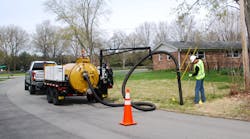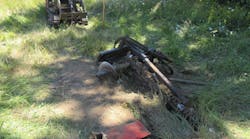While bright lights, casinos and fabulous hotels come to mind when you hear the name "Las Vegas," pervious concrete probably does not. This zero slump concrete mix is becoming increasingly popular as the choice mix in building parking lots and ramps in Florida and California, where frequent storms are heavy and runoff can pose an environmental hazard. However, pervious concrete is making its debut in the desert — on the Las Vegas Strip at the MGM Residence Towers.
All three MGM Residence Towers require a drive entrance on top of an underground parking ramp. Familiar with the benefits of pervious concrete from its projects in Florida, Turnberry, the developer for this job, specified the mix as a proactive approach in preventing water runoff from accumulating on top of or leaking into the underground parking area.
While the first two-thirds of the pour for the second tower went smoothly, chuting from a ready-mix truck, the last third of the pour took a detour, according to Bob Sanders, the project superintendent with Marnell Corrao Associates. The grade differential for the last third of the pervious pour area was 30 inches, which would not allow the trucks to back down to the pour. In addition, only 5 yards of pervious could be poured at one time because of weight restrictions on the parking structure beneath.
With no room or support to maneuver, ready-mix trucks with the pervious concrete could not access the area. As a result, Sanders and his team turned to Quinn Concrete Pumping for the only way to complete the job — Quinn's Putzmeister Telebelt® TB 130.
What makes pervious concrete so different from conventional concrete is what also makes it so challenging to place. A porous, gap-graded, permeable concrete, pervious is virtually unpumpable because of its make-up of Portland cement, little or no fine aggregate, water admixtures, open-celled stones, and gravel. The lack of excess water means that placement must occur very quickly.
A general rule of thumb for most pervious placements is to keep construction traffic (primarily vehicular) away from the pervious pavement area during construction to prevent compaction of any underlying soil and loss of infiltrative capacity.
In the case of the MGM Residence Towers job, the Telebelt TB 130 was the only equipment that could place the pervious mix with the convenience the project required.
Although pervious concrete has been around since the mid-19th century, it is definitely new to Las Vegas. "It was a learning curve for all the workers," Sanders says. "We found out that pervious doesn't require much finishing, and we had to use a compactor to level the pervious out."
He notes that Nevada Ready Mix Corp. provided instructions and helpful information on placing the pervious because they had already poured the first two-thirds of the 325-cubic-yard pour for the second tower with their ready-mix trucks.
Mike Sherwood of Nevada Ready Mix had never used pervious concrete on a job and was impressed with how easy the mix was to place. "It was not hard to produce the pervious concrete mix," he says. "Supplying the pervious went smoothly. We were well informed on the capabilities of the mix before the pour took place."
According to Sherwood, most of the information was dispersed to them from the Southern Nevada Concrete Aggregate Association, the California Cement Promotion Council and the local chapter of the American Concrete Institute (ACI). Seminars were also held to better educate the workers for future and upcoming pervious jobs. As a result, the Nevada Ready Mix team was well prepared to undertake this mix request. "It was effective that we had information and exposure to tackle this project," says Sherwood.
Constructing the driveway required first installing a waterproofing system, then placing the pervious concrete. This was then topped with a protective sealant to prevent contamination of the pervious, 2 inches of sand, and finally, 2-inch brick pavers were positioned on top. As Sanders explains, the driveway composition prevents water from leaking into or accumulating on top of the parking structure, "Rain will go through the brick pavers, down through the pervious and then finally the rain drains into the waterproofing system. That's why we used pervious: because it lets the water filtrate through it to the waterproofing system."
Sanders and his team found this challenging environment posed no obstacle for the Telebelt TB 130, because of its placement versatility and its smooth, fast conveying abilities.
When using a ready-mix truck, wood planks needed to be placed over the waterproof sealant layer that was laid before the pervious concrete mix so the truck would not damage the work that had been completed. This process required advance setup time. With the TB 130 on hand, the ready-mix trucks were never close enough to the site of placement to cause any damage. The TB 130 was able to maneuver around the job site freely and place the pervious exactly where it was needed for the 110-cubic-yard pour. Sanders notes that Marnell Corrao Associates has used Putzmeister Telebelts in the past to place regular concrete mixes and backfill on many projects, including the Wynn Las Vegas Hotel.
Steve Heimark, operations manager for Quinn Concrete Pumping, says the TB 130 handled the pervious concrete very well and welcomes more jobs that require the versatility of a Putzmeister Telebelt. "Certain jobs need a Telebelt to get the job done," he says. "Our company is ready to take on those tasks.
"When we were told that the MGM Residence Towers drive entrances would require pervious concrete, we were surprised," Heimark notes. However, he had no problem with the pervious and feels that this type of mix could be a good thing for Las Vegas and its surrounding areas. "The ground in the Nevada area doesn't soak up water well at all," he continues. "Las Vegas could get a half-inch of rain and downtown would be flooded. The rain runs on top of the ground and can't find a way or a channel to disperse or make it to a flood channel."
According to Heimark, "As the city has grown, there has been an increased effort to find other possible flood channels for the Nevada area. They're always looking for better options for drainage. Pervious may be one way to address this issue." he says.
With the ongoing development of Las Vegas and its environs has come the demand for more living options on or near the Las Vegas Strip. There's no question the MGM Residence Towers are being constructed at a prime time and in a prime location. The three towers have matching characteristics: 38 floors, with 576 one- and two-bedroom units. The first of the three towers was completed in September 2004. The second tower started in spring 2005, and the third tower started in early 2006, with completion set for mid-2007.




